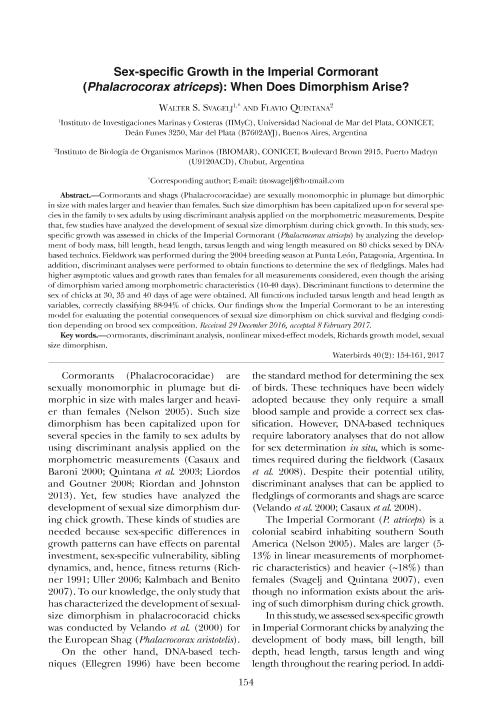Artículo
Sex-Specific Growth in the Imperial Cormorant (Phalacrocorax atriceps): When Does Dimorphism Arise?
Fecha de publicación:
06/2017
Editorial:
Waterbird Society
Revista:
Waterbirds
ISSN:
1524-4695
e-ISSN:
1938-5390
Idioma:
Inglés
Tipo de recurso:
Artículo publicado
Clasificación temática:
Resumen
Cormorants and shags (Phalacrocoracidae) are sexually monomorphic in plumage but dimorphic in size with males larger and heavier than females. Such size dimorphism has been capitalized upon for several species in the family to sex adults by using discriminant analysis applied on the morphometric measurements. Despite that, few studies have analyzed the development of sexual size dimorphism during chick growth. In this study, sexspecific growth was assessed in chicks of the Imperial Cormorant (Phalacrocorax atriceps) by analyzing the development of body mass, bill length, head length, tarsus length and wing length measured on 80 chicks sexed by DNA-based technics. Fieldwork was performed during the 2004 breeding season at Punta León, Patagonia, Argentina. In addition, discriminant analyses were performed to obtain functions to determine the sex of fledglings. Males had higher asymptotic values and growth rates than females for all measurements considered, even though the arising of dimorphism varied among morphometric characteristics (10-40 days). Discriminant functions to determine the sex of chicks at 30, 35 and 40 days of age were obtained. All functions included tarsus length and head length as variables, correctly classifying 88-94% of chicks. Our findings show the Imperial Cormorant to be an interesting model for evaluating the potential consequences of sexual size dimorphism on chick survival and fledging condition depending on brood sex composition.
Archivos asociados
Licencia
Identificadores
Colecciones
Articulos(IIMYC)
Articulos de INSTITUTO DE INVESTIGACIONES MARINAS Y COSTERAS
Articulos de INSTITUTO DE INVESTIGACIONES MARINAS Y COSTERAS
Citación
Svagelj, Walter Sergio; Quintana, Flavio Roberto; Sex-Specific Growth in the Imperial Cormorant (Phalacrocorax atriceps): When Does Dimorphism Arise?; Waterbird Society; Waterbirds; 40; 2; 6-2017; 154-161
Compartir
Altmétricas




